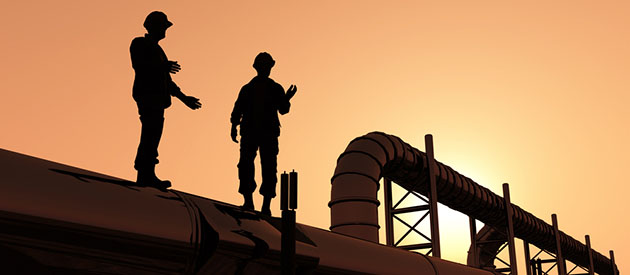What's got everyone so heated?
It seems a lot of people are concerned, confused, and even outraged over a recent Executive Order signed by President Obama regarding the development of unconventional natural gas formations here in the United States. The executive order, issued on April 13, calls for greater coordination in federal oversight of "fracking"—a revolutionary, yet-still-nascent process of extracting natural gas from rock bed.
Questions ranged from the impacts of new regulatory standards to industry support levels. Concerns stretched from sector performance outlooks all the way to the highly alarming and somewhat foolish argument that such an order precipitates a "government takeover of the natural gas industry."
Now, I'm overly cautious when the government announces any role in business. But when you take a close look, this announcement is rather benign.
That's why I'd like to take a few minutes today to explore the ongoing developments in this story, set a few eager minds at ease, and explain a few benefits—yes, benefits—of this presidential directive.
In the age of 24-hour media, one marked by rampant polarization and limited policy analysis, we often hear only a fraction of the full story.
And yes, it's easy to get caught up in the immediacy or negative impacts of one single act.
But there's a lot to like here.
This Natural Gas Boom Came Along Very, Very Fast
The real story starts with the remarkable transformation of the natural gas sector here in the United States over the last five years.
The technological breakthroughs in fracking and horizontal drilling have revolutionized a national market and created an immense glut of supply across the United States. Hydraulic fracturing enables drillers to use high-pressure water, sand, and chemicals to break open seams in shale rock. This makes it easier to extract natural gas.
But this transformation has occurred so quickly that Federal agencies have been scrambling to keep up with the breakthrough. Nearly a dozen agencies have skin in the game when it comes to regulating and conforming to major Acts of Congress (including the Department of Defense, the Department of Agriculture, the Department of Transportation, the EPA, and so on).
Every agency conducts studies, examines process performance, evaluates legalities, and all of their work does take time (sometimes too much).
But when they are individually scrambling to set standards in conformity with major legislative acts, it can be very difficult for energy producers to meet expected regulations all at once.
Hence, this executive order.
The ultimate goal is to improve process and communication, something that has been sorely lacking in energy policy for the better part of 40 years. Improved communication between the agencies would enable greater understanding of one another's work, provide greater coordination between agency heads on this critical policy issue, and, specifically, reduce overlapping regulations.
But don't just take my word for it.
The Natural Gas Industry Supports This Order
The term "executive order" does have a negative connotation to it, since it sounds like an imperial command from high above. But in reality, this is similar to a corporate CEO telling the presidents and executives in various company divisions to meet now and then to discuss major company business.
And natural gas production is major business in the United States.
Nowhere in the order does it mention that the government will be involved in the actual production. In fact, it specifically states, "natural gas production is carried out by private firms."
But Federal agencies are at the service of the Executive Branch. Therefore, this order is directed at the agency leaders and their communications teams. These divisions are very siloed and conduct many similar projects, studies, and analyses. The goal is to expedite and facilitate greater coordination.
Still, if anyone is overly concerned about this being a situation where the government is expanding its regulatory overreach, there's industry support here.
The American Petroleum Institute (API) came out and supported this order just after it was released.
API is the largest trade association for the oil and gas industry in the country; it represents roughly 400 companies within the entire energy sector.
"We're pleased that the White House recognizes the need to coordinate the efforts of the 10 federal agencies that are reviewing, studying or proposing new regulations on natural gas development and hydraulic fracturing," said Jack Gerard, API president and CEO, in a statement. "We have called on the White House to rein in these uncoordinated activities to avoid unnecessary and overlapping federal regulatory efforts and are pleased to see forward progress."
Gerard has been outspoken and critical of the President, the EPA, the DOE, and just about every industry regulator there is in the past. . . and more than once, at least. So to see his support here is a positive sign for owners and operators in the unconventional business.
(On a personal note, I did some work with API in the wake of the BP oil spill. Recognizing their pro-business, "free-market" philosophy to the industry, I'd say that if Jack Gerard is "praising" this order, it's likely a good sign.)
Which brings us to the other concern. . .
Will There Be New Standards and Regulations?
As to the overall environmental impact of hydraulic fracking and horizontal drilling, the jury is out—and will be out for some time.
It's vital to give it some time while industry experts, agencies, and independent sources conduct analysis on the economic, environmental, and societal benefits and drawbacks of these processes.
But while concerns about overregulation in this sector were brewing up after this announcement, a new story unfolded yesterday that adds credibility to the companies involved to this ongoing drama.
Nearly a dozen major energy companies, including Chevron Corp. and Royal Dutch Shell, announced they had developed standards for hydraulic fracturing in the Utica shale formation.
These voluntary "best practices" are designed for drilling, well design, water use, and equipment use. So, the industry is being proactive in setting standards to coincide with recent announcements from several additional agencies.
Hopefully, their actions will send a clear signal that they take the balance between energy development and environmental stewardship seriously.
More to this Story is on the Way
Kent said nearly 18 months ago that shale gas is too large a target for the operators to avoid. With so much money to be made over the long term, greater coordination between the agencies and greater adoption of best practices were inevitable.
This has been just the latest part of an ongoing drama that will continue to unfold and provide many profitable opportunities in the future.
Patience, unfortunately, is the commodity we really need when dealing with government and private sector coordination.
But the opportunities will come, and this revolution in unconventional natural gas couldn't come at a better time.
As Kent and I have explained at great length, the price of natural gas will rise again. It's inevitable. And there is plenty of fundamental evidence in other commodity markets as to why. It might not be tomorrow, but it's coming. The problem is that some seem so overly focused on the near-term asset performance that they fail to recognize real long-term potential.
Kent's identified four big factors moving forward that will push the price back up, including the massive transfer to natural gas as a major replacement to nuclear and coal-fired power plants.
So don't let misinformation about policy and short-termism scare you away from the massive potential on the horizon.
I'm certainly wary of government's role in economic development, but from a process standpoint, it's important to improve communications between federal agencies. In fact, it could be a starting point to something much bigger.
I'll continue to cover this story moving forward, particularly as we approach the greater opportunities of midstream transportation and LNG exporting.
Best,
James Baldwin
Money Morning


























































